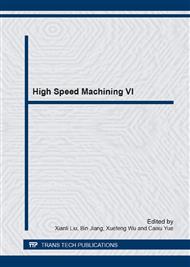[1]
Everitt P., Doggett I, Advanced Ceramics in demands, CeramicIndustry Report, (2009), 13-16.
Google Scholar
[2]
Eleonora Ferraris, Tom Mestrom, RongBian, Machinability investigation on high speed hard turning of ZrO2 withPCD tools, Procedia CIRP, 1 (2012), 500-505.
DOI: 10.1016/j.procir.2012.04.089
Google Scholar
[3]
Ferraris E, Reynaerts D, Lauwers B, Micro-EDM process investigation and comparison performance of Al3O2 and ZrO2 based ceramic composites. CIRP Annals - Manufacturing Technology, (2011), 60: 235-238.
DOI: 10.1016/j.cirp.2011.03.131
Google Scholar
[4]
Hongtao Li, Xinmin Lai, Chengfeng Li, Modelling and experimental analysis ofthe effects of tool wear, minimum chipthickness and micro tool geometry on thesurface roughness in micro-end-milling, J. Micromech. Microeng, 18(2008).
DOI: 10.1088/0960-1317/18/2/025006
Google Scholar
[5]
Bifano TG, Dow TA, Scattergood RO. Ductile-regime grinding – a newtechnology for machining brittle materials. Journal of Engineering for Industry-Transactions of the Asme, (1991), 113: 184–9.
DOI: 10.1115/1.2899676
Google Scholar
[6]
Dornfeld D, Min S, Takeuchi Y., Recent advances in mechanical micromachining, CIRP Annals – Manufacturing Technology, (2006), 55: 745-68.
DOI: 10.1016/j.cirp.2006.10.006
Google Scholar
[7]
RongBian, EleonoraFerrarisb, Ning He, Process investigation on meso-scale hard milling of ZrO2by diamond coated tools, Precision Engineering, (2013), 38: 82-91.
DOI: 10.1016/j.precisioneng.2013.07.007
Google Scholar
[8]
Cheng X, Wang ZG, NakamotoK, Design and development of a micro polycrystalline diamond ball end mill for micro/nano freeform machining of hard and brittle materials, J MicromechMicroeng, (2009)19.
DOI: 10.1088/0960-1317/19/11/115022
Google Scholar
[9]
Cheng X, Nakamoto K, Sugai M, Development of ultra-precision machining system with unique wire EDM tool fabrication system for micro/nano-machining. Cirp Ann-ManufTechn, (2008), 57: 415-420.
DOI: 10.1016/j.cirp.2008.03.137
Google Scholar
[10]
Li P, Micromilling of hardened tool steels, PhD Thesis, TeschnischeUniversiteit Delft, (2009).
Google Scholar
[11]
Liu X, DeVor RE, Kapoor SG, Ehmann KF, The mechanicsof machining at the microscale: assessment of the current state ofthe science. J ManufSciEng, (2004), 126: 666-678.
DOI: 10.1115/1.1813469
Google Scholar


